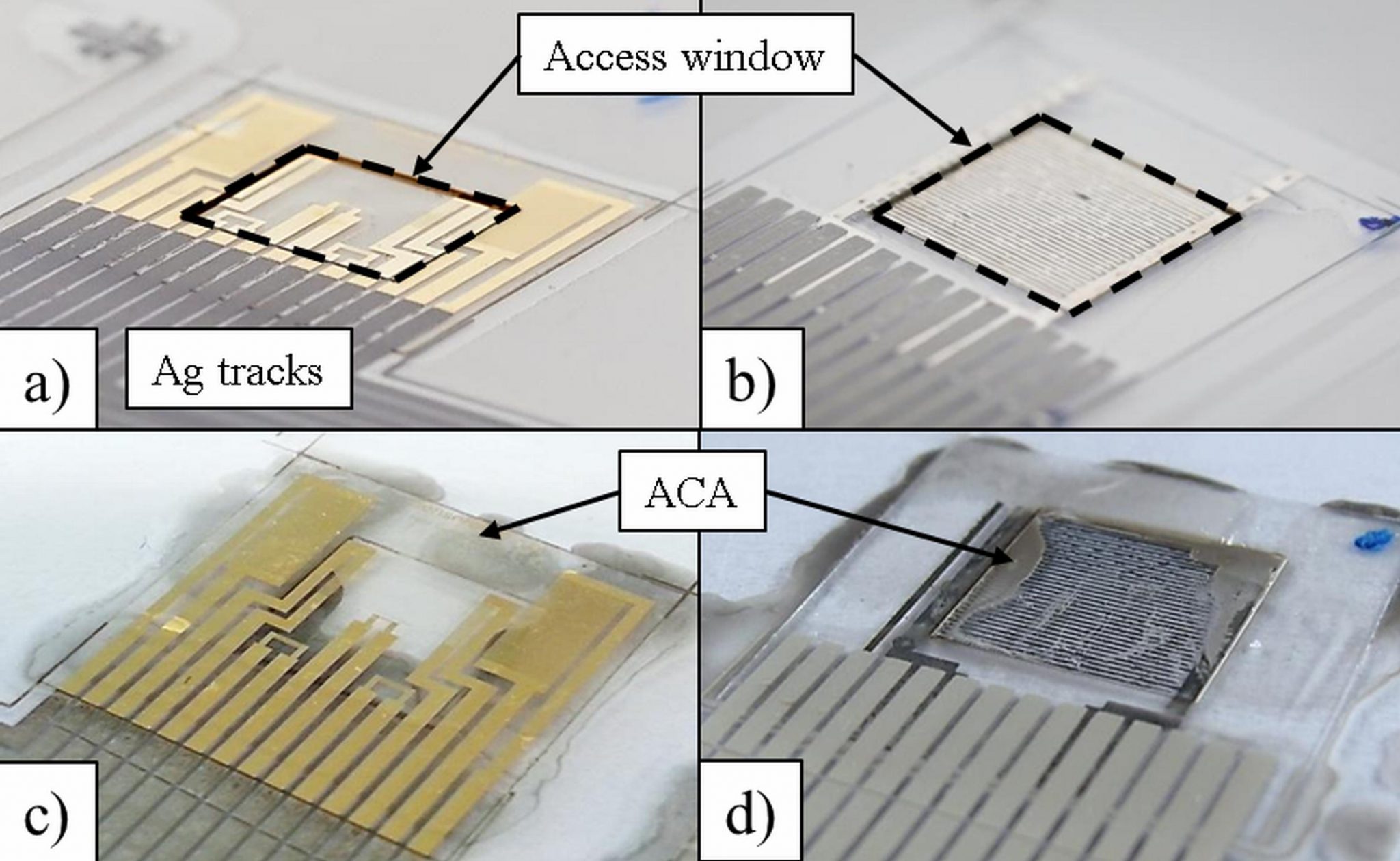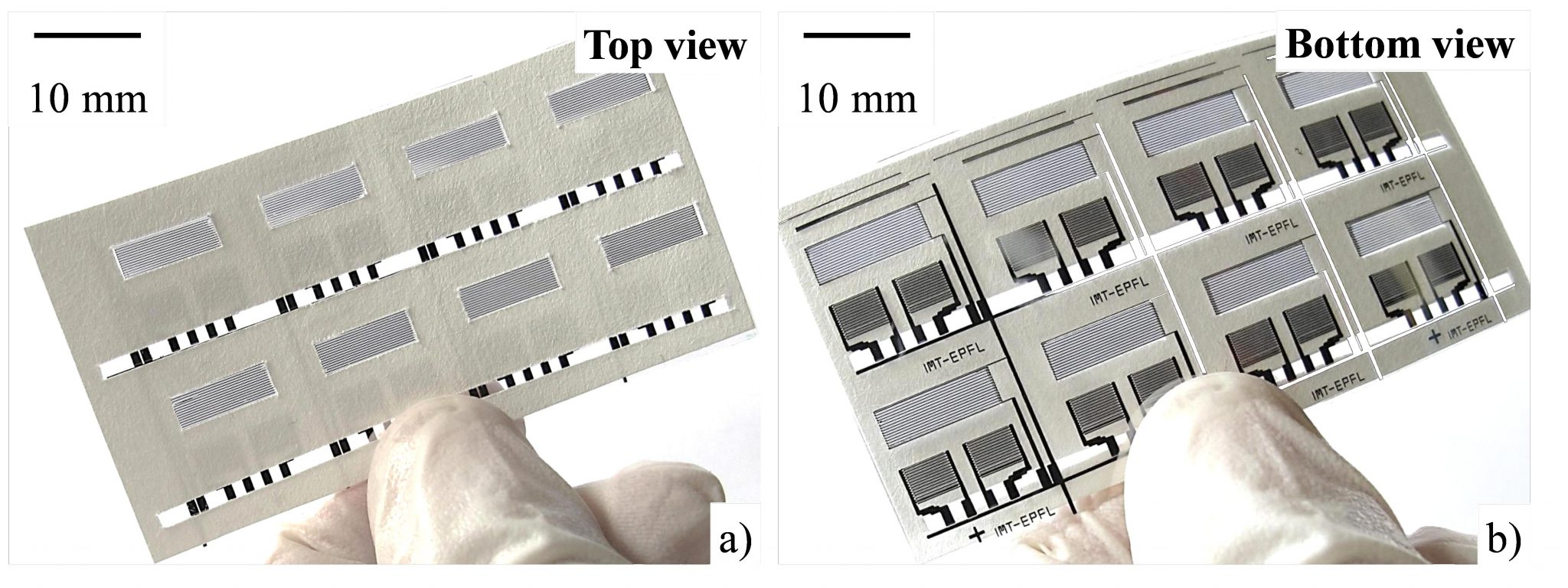Following printed electronics industrial trends such as large-area and high-volume manufacturing, the development of imperceptible and integrated systems on flexible foils is of great importance. Such systems are based on the co-integration of printed and non-printed devices on foil. This includes among others the integration of sensors, power sources (batteries), electronics (Si chips) and antennas to realize novel Systems-In-Foil and smart packages. These components need to be assembled mechanically and interconnected electrically in a low-cost, large-area, high-volume and high-reliability manner on flexible polymeric foils, in one foil (1F) or foil to foil (F2F) approaches.
Foil-to-foil integration
With the collaboration of Holst Centre (The Netherlands), we have developed two low-temperature hybrid integration methods of foil-based components onto polyethylene naphthalate (PEN) substrates, using, for demonstration purposes, capacitive and resistive sensors structures. The first approach uses a combination of laser-ablated vias through foil and isotropic conductive adhesive (ICA) paste (referred as TFV. The second one uses stencil-printed anisotropic conductive adhesive paste (referred as ACA) to connect electrically and fixate mechanically the foil-based components (both techniques on Figure 1). This novel foil-to-foil ACA integration, differs from conventional rigid-based (i.e. Si chips) interconnections presented before, mainly due to bonding area variation, uneven force distribution and amount of filler particles along their thicknesses.
Low complexity, low processing energy and high yield electrical interconnections were achieved for both methods. The ACA method requires less processing steps, while the TFV method was shown to be more robust to bending forces and relatively cheaper (i.e. ICA less expensive than ACA pastes). For both methods, electrical interconnections withstood more than 900 h of environmental ageing, verifying their operation at high humidity and drastic temperature changes.

Figure 1: Optical images of the: a) TFV interconnected gold sensor, b) TFV interconnected inkjet-printed sensor, c) ACA interconnected gold sensor, d) ACA interconnected inkjet-printed sensor.
Silicon-to-foil integration
The combination of electronics on polymeric substrates appears as a new generation of technology platform. It integrates multiple functionalities from the microelectronic chips with the benefits of flexible and low cost polymers. However, using low-cost polymers as substrate requires the processing temperatures to be low. Therefore we have been investigating on low temperature silicon-to-foil assembly processes. One approach is to use a dry film photoresist as a bonding and an interconnecting layer. This layer is first patterned using photolithography process. After its development, the interconnection vias were filled up with conductive glue and finally the chip is bonded to the substrate by applying pressure and heat (Figure 4). This technique is compatible with printed (e.g. inkjet, screen, gravure, etc.) circuitry and low temperature (< 85 °C) polymers. Moreover, it is possible to achieve high density of electrical interconnections, the ones specified for Si bare dies.
Encapsulation techniques
Encapsulation techniques have been demonstrated for printed chemical gas sensors on flexible polymeric substrates. A flexible encapsulation technique based on dry film photoresist rims capped with a gas permeable micro-porous membrane was developed in order to protect the gas sensing system and make it more robust and reliable. The encapsulation was performed by lamination techniques and with flexible polymers in order to increase their mechanical robustness when bending forces are applied.

Figure 2. Pictures of the (a) top and (b) bottom views of the interdigitated electrodes capacitive sensors for gas analytes (e.g. water vapor, ammonia, VOC’s) and resistive temperature detector (RTD) for temperature compensation.
Scientific publications
A. Vasquez Quintero, D. Briand, N.F. de Rooij, Flip-chip integration of Si bare dies on polymeric substrates at low temperature using ICA vias made in dry film photoresist, Journal of Micromechanics and Microengineering, 25 (2015) 045013.
A. Vasquez Quintero, B. van Remoortere, E.C.P. Smits, J. van den Brand, D. Briand, H.F.M. Schoo, N.F. de Rooij, Foil-to-Foil lamination and electrical interconnection of printed components on flexible substrates, Microelectronic Engineering, 110 (2013) 52-58.
F. Molina-Lopez, A. Vásquez Quintero, G. Mattana, D. Briand, N.F. de Rooij, Large-area compatible fabrication and encapsulation of inkjet printed humidity sensors on flexible foils with integrated thermal compensation, J. Micromech. Microeng. 23 (2013) 025012.